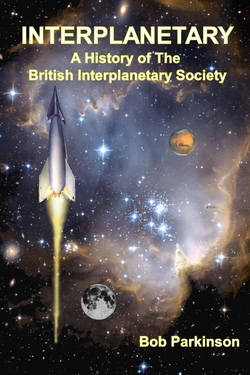Centauri Dreams
Imagining and Planning Interstellar Exploration
Getting JWST Aloft
No one said this was going to be easy. Delays involving the James Webb Space Telescope are frustrating, with NASA now talking about a launch in mid-2020 instead of next year, and the uncertain prospect of a great deal of further testing and new expenditures that could run the project over budget, necessitating further congressional approval. It’s hard to look back at the original Webb projections without wincing. When first proposed, estimates on the space observatory ran up to $3.5 billion, a hefty price tag indeed, though the science payoff looked to be immense. It was in 2011 that a figure of $8 billion emerged; the project now has a Congressionally-mandated cost cap of $8.8 billion.
And now, looking forward, we have Thomas Zurbuchen, speaking for NASA’s Science Mission Directorate, explicitly saying “We don’t really fully know what the exact cost will be…”
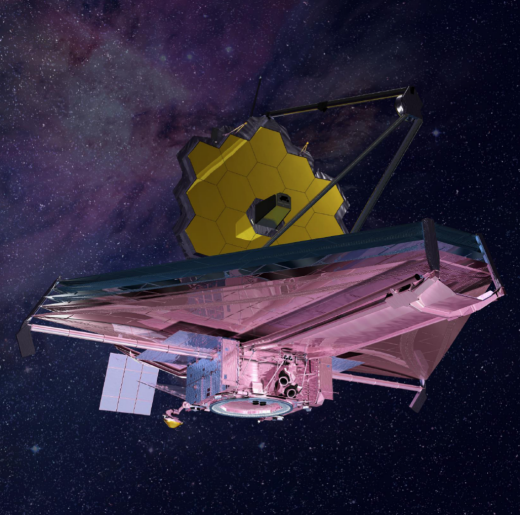
Image: Illustration of NASA’s James Webb Space Telescope. Credit: NASA.
Projects this big invariably take us into the realm of acronyms, with the project’s Standing Review Board (SRB) concluding that further time is necessary to integrate the various components of JWST. But we also learn that NASA is setting up an Independent Review Board (IRB) to complement the SRB findings. The space agency will look at the findings from both boards and consider their recommendations by way of taking us to a more specific launch schedule, with an assessment due in a report to Congress this summer. This NASA news release also talks about “Additional steps to address project challenges include increasing NASA engineering oversight, personnel changes, and new management reporting structures.”
There’s no question about the challenges JWST presents. Its spacecraft element is made up of the huge sunshield (the size of a tennis court), along with the spacecraft bus including the flight avionics, power system and solar panels. The collapsible sun shield must be folded and re-folded during the test process. Eventually it must be mated with the 6.5 meter telescope and science payload. The latter were successfully tested in 2017 at Johnson Space Center, with the telescope element being delivered to Northrop Grumman earlier this year.
Both halves of the observatory are now in the same facility for the first time. Ahead for the spacecraft element is vibrational, acoustic and thermal testing, necessary before the observatory can be fully integrated and pronounced ready for flight. The area of concern is the sun shield and bus, both developed by Northrop Grumman. Contributing to the delay, according to this Lee Billings essay, is a series of tears that appeared on the shield while being tested for deployment. The shield is said to have created a snagging hazard, forcing the addition of springs to prevent it from sagging. Other errors have involved the spacecraft thrusters.
What to do? Northrop Grumman teams are now working on the telescope 24 hours a day, while NASA is calling in the cavalry, as Marina Koren describes in The Atlantic:
Nasa announced some measures they would take at Northrop Grumman’s facility in California, where all of Webb’s parts currently reside. The space agency said they will increase engineering oversight at the facility in Redondo Beach and will track the company’s test reports on a weekly basis. Senior management from nasa’s Goddard Space Flight Center in Maryland, where much of the telescope was constructed, will work out of Northrop Grumman’s offices on a permanent basis. Northrop Grumman’s project manager for Webb will report directly to C-suite level executives at the company “to help remove roadblocks to success within the company,” the officials said.
Northrop Grumman is the prime contractor for JWST, but it appears that deeper NASA involvement in the process is forced by events. Ahead for the observatory is the tough environmental testing of sun shield and bus that the telescope and science instruments have already received. This in itself is a matter of several months, after which JWST can be assembled and tested in final form. The feeling at this end is that JWST has become so expensive, so pivotal in our astronomical roadmap, that it is too big and too expensive to fail.
That means its launch and deployment are going to be fraught with tension. 100 times more powerful than Hubble, JWST will operate 1.5 million kilometers from Earth, meaning that servicing missions by astronauts like Hubble has received will not happen. What would the path forward be if we lost JWST because the complex deployment process failed?
Also worth pondering: What will be the effect of any JWST overspending on the WFIRST mission? The Wide Field Infrared Survey Telescope has had its funding restored and operations continue, but we can’t rule out future attempts to cut the budget or even derail the program entirely. In the realm of technology, WFIRST may prove the easier of the two missions to complete, as this story in Nature points out:
JWST and WFIRST are very different technologically, says Jon Morse, chief executive of Boldly Go Institute, a space-exploration organization in New York City, and former head of NASA’s astrophysics division. JWST involves complex designs that have never been tested before, such as the enormous sunshield. WFIRST will use a well-understood 2.4-metre mirror design that does not require lots of new technology.
“WFIRST is not likely to develop the cost problems of the same magnitude as JWST,” Morse says.
Assuming its operations budget isn’t too severely raided to pay for JWST’s extra costs. By comparison, WFIRST’s own budget cap is a relatively svelte $3.2 billion.

TRAPPIST-1: An Abundance of Water?
Too much water helps planetary habitability not one bit. And while we find the availability of surface water a useful way of describing a potentially habitable world, we’re learning that some planets may have water in such abundance that life may never have the chance to emerge. It would be a shame if the numerous worlds orbiting TRAPPIST-1 fell into this scenario, but a multidisciplinary team from Arizona State University is making a strong case for the prospect.
What’s wrong with water? Let Natalie Hinkel (Vanderbilt University) explain. Hinkel worked with ASU’s Cayman Unterborn, Steven Desch and Alejandro Lorenzo on the question of water composition in these worlds. Coleridge’s “Rime of the Ancient Mariner” comes to mind — “Water, water, every where / Nor any drop to drink.” But in this case, there is plenty to drink, which is precisely the problem. Says Hinkel:
“We typically think having liquid water on a planet as a way to start life, since life, as we know it on Earth, is composed mostly of water and requires it to live. However, a planet that is a water world, or one that doesn’t have any surface above the water, does not have the important geochemical or elemental cycles that are absolutely necessary for life.”
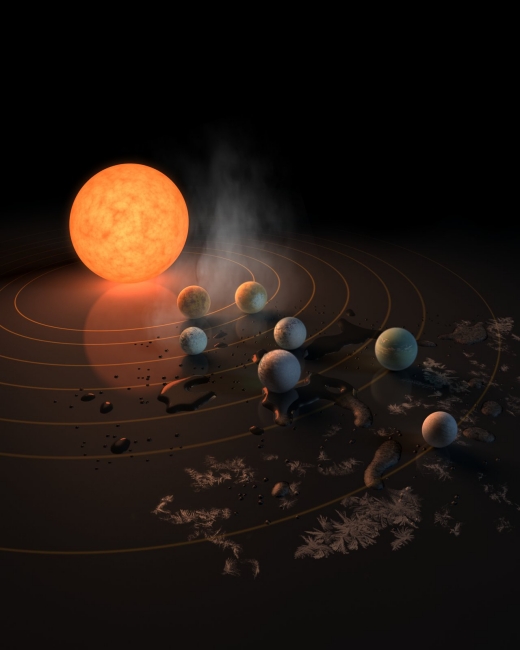
Image: A nice visualization of the TRAPPIST-1 planets, here suggesting their relationship to the ‘snowline.’ As we’ll see below, what these planets are made of has implications for where they formed. Credit & copyright: NASA/Tim Pyle and Robert Hurt.
Not a good prospect, then, if the work of these researchers is any indication. What Unterborn et al. are saying in their paper in Nature Astronomy is that the TRAPPIST-1 planets are lighter than we would expect given our measurements of their mass and volume. All seven planets here appear to be less dense than rock. Remember, this is a transiting system, meaning we have constraints on mass and radius for all seven, allowing us to calculate density.
While low density worlds might well have a large gaseous envelope, the TRAPPIST-1 planets turn out to be not massive enough to hold onto the gas they would need to make up what Unterborn calls the ‘density deficit.’ If they somehow did hold onto the needed gas, they would be much puffier planets than what we see. The researchers argue that the low density component must be water, so the question becomes, how much water is there?
The numbers are daunting. Bear in mind as we look at them that the Earth, even with its magnificent oceans, is but 0.02% water by mass. Around TRAPPIST-1, the ‘dry’ inner planets b and c are likely to have less than 15 percent water by mass. Outer planets f and g are consistent with having more than 50 percent water by mass. These numbers will vary as we continue to constrain the masses of the planets, but the trend is clear enough.
“What we are seeing for the first time are Earth-sized planets that have a lot of water or ice on them,” said Steven Desch.
Which gets us to what planets like this can tell us about their formation and evolution. Planets with this much water — assuming water is the explanation for the density issue — should not have formed within the ‘snowline,’ that region within which water exists as a vapor and cannot be incorporated into a forming planet. Unterborn and team are clear on this point: The TRAPPIST-1 planets must have formed beyond the snowline and migrated to their current orbits. Indeed, these planets must have migrated from a position at least twice as far from the parent star as they are now. Have a look at the graph below to get the idea.
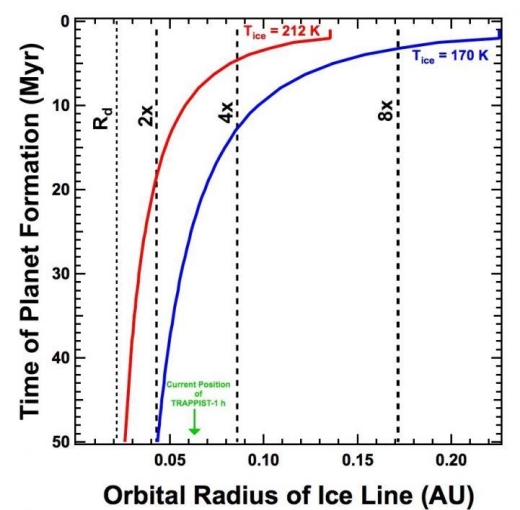
Image: This graph shows the minimum starting distances of the ice-rich TRAPPIST-1 planets (especially f and g) from their star (horizontal axis) as a function of how quickly they formed after their host star was born (vertical axis). The blue line represents a model where water condenses to ice at 170 K, as in our solar system’s planet-forming disk. The red line applies to water condensing to ice at 212 K, appropriate to the TRAPPIST-1 disk. If planets formed quickly, they must have formed farther away (and migrated in a greater distance) to contain significant ice. Because TRAPPIST-1 dims over time, if the planets formed later, they could have formed closer to the host star and still be ice-rich. Credit: Unterborn et al. / ASU.
This isn’t the first time we’ve seen migration discussed in relation to TRAPPIST-1. Simon Grimm (University of Bern Centre for Space and Habitability) and colleagues have looked at migration, noting that the resonant orbits here — the planets form a single resonant chain — is an indication of a slow migration consistent with the current perceived stability.
Other researchers have likewise addressed migration, including Chris Ormel (University of Amsterdam) and team, who look at planetary formation at the snowline itself in what they call a ‘resonant convoy,’ with the outer planets ‘pushing’ on the inner ones. So the idea of migration at TRAPPIST-1 is not new. What is new in the Unterborn et al. work is the use of planetary composition to add weight to the overall case for migration, which allows the team to quantify how much migration actually took place.
We’ve lucked out when it comes to nearby red dwarfs. TRAPPIST-1 will clearly be a primary source of data for red dwarf planets as we address the issue of habitability that their density and formation history implies. And then there’s that intriguing planet around Proxima Centauri…
The paper is Unterborn et al., “Inward migration of the TRAPPIST-1 planets as inferred from their water-rich compositions,” Nature Astronomy 19 March 2018 (abstract). The Grimm paper is Grimm et al., “The nature of the TRAPPIST-1 exoplanets,” in press at Astronomy & Astrophysics (preprint). The Ormel paper is Ormel et al., “Formation of Trappist-1 and other compact systems,” Astronomy & Astrophysics Vol. 604 (August 2017) (abstract).

Interplanetary Exploration: Application of the Solar Sail and Falcon Heavy
Gregory Matloff’s contributions to interstellar studies need scant introduction, given their significance to solar-and beamed sail development for decades, and their visibility through books like The Starflight Handbook (1989) and Deep Space Probes (2005). A quick check of the bibliography online will demonstrate just how active Greg continues to be in analyzing the human future in space, as well as his newfound interest in the nature of consciousness (Star Light, Star Bright, 2016). The paper that follows grows out of Greg’s presentation at the 2016 iteration of the Tennessee Valley Interstellar Workshop, where he discussed ways to advance deep space exploration using near term technologies like Falcon Heavy, in conjunction with the solar sail capabilities he has so long championed. Read on for an examination of human factors beyond lunar orbit and a description of a useful near-term mission that could reach an object much closer than Mars relying on both chemical and sail capabilities. Dr. Matloff is a professor of physics at New York City College of Technology, CUNY.
ABSTRACT
The possibility of applying the Space-X Falcon-Heavy booster to human exploration of the inner solar system is discussed. A human-rated Dragon command module and an inflatable habitat module would house and support the 2-4 person crew during a ~1 year interplanetary venture. To minimize effects of galactic cosmic rays, older astronauts should conduct the mission during Solar Maximum. Crew life support is discussed as is application of a ~1-km square solar photon sail. The sail would be applied to rendezvous with the destination Near Earth Object (NEO) and to accelerate the spacecraft on its return to Earth. An on-line NASA trajectory browser has been used to examine optimized trajectories and destinations during 2025-2026. A suitable destination with well established solar-orbital parameters is Asteroid 2009 HC. Because the NASA Space Launch System (SLS) has a greater throw mass than the Falcon-Heavy, the primary propulsion for NEO rendezvous and Earth return would likely be a chemical rocket. The sail would be used in this case as an abort mechanism and a back-up for the primary propulsion system. In either scenario, a single Falcon-Heavy or SLS launch would be adequate.
Keywords: NEO Exploration, Falcon-Heavy, Dragon, BEAM, GCR, ECLSS, SLS
Introduction
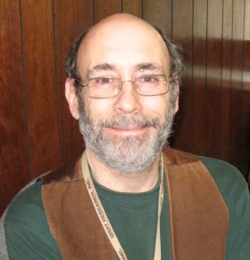
The United States is currently developing two separate approaches to launching inner solar system exploration by human crews beginning in around 2020: the NASA Space Launch System (SLS) and the commercial Space-X Falcon Heavy [1,2]. The advantage of the SLS is its greater throw-weight on interplanetary trajectories. A disadvantage of SLS is the cost permission and constraints imposed by the current state of the US federal government. Although Falcon-Heavy has less launch capacity than the SLS, this booster is a composite of three existing and mass produced Falcon-9 boosters. These have an excellent reliability record to date on NASA-sponsored resupply missions to the International Space Station (ISS) and commercial launches. Experiments indicate that the Falcon 9 first stage may eventually be recovered and reused, which promises to greatly reduce the cost of space missions to low Earth orbit (LEO) and beyond.
This paper concentrates upon interplanetary ventures using a single Falcon-Heavy launcher and a small crew (2-4 people). As well as a Dragon V2 capsule appropriately modified for interplanetary application (3), an inflatable Bigelow space habitat similar to the one to be launched to the ISS [4} in the near future will be used for crews habitability. Life support for the crew on their 1-2 year interplanetary venture will utilize recycling of oxygen and water. Food recycling by biological means will likely not be ready by 2020.
After the spacecraft is launched towards Mars, a state-of-the-art solar photon sail with a dimension of ~0.7 km will be unfurled. This will allow, as will be demonstrated, non-rocket accelerations of 1-2 km/s per month in the solar system region between Earth and Mars.
A recent comprehensive study of in-space radiation effects reveals that galactic cosmic radiation beyond LEO is reduced by a factor of ~5 above LEO, if missions are conducted during solar maximum. During solar flares and coronal plasma discharges, the crew could be protected by aligning the Dragon’s heat shield between the crew quarters and the Sun.
Human landings on Mars will not be possible using a single Dragon launch. But a host of Near Earth Objects of asteroidal and cometary origin and possibly the Martian satellites Deimos and Phobos will be open to human explorers.
But any human expedition beyond the Moon will likely require cruise durations of months to years. Solar and galactic cosmic radiation will certainly be a limiting issue. The possibilities and effectiveness of using the capsule and habitat mass for self shielding is discussed in the next section.
Falcon-Heavy Interplanetary Throw Mass and Cosmic Ray Shielding
According to Ref. 2, a Falcon-Heavy is capable of projecting 13,200 kg on a trans-Mars trajectory. From Ref. 3, the dry mass of a Dragon V2 capsule is 4200 kg and the endurance of this spacecraft is about 2 years in space. The mass of the BEAM inflatable module is 1360 kg [4].
From Ref. 3, the Dragon’s configuration can be approximated by a cone with a diameter of about 3.7 m and a height of about 6.1 m. From Ref. 4, the BEAM inflatable habitat can be approximated by a cylinder with a diameter of about 3.2 m and a length of about 4 m. Assuming that the base of the Dragon abuts one of the circular end caps of the BEAM, it is easy to demonstrate that the surface area of the spacecraft is about 100 m2. Assuming that all of the Falcon’s throw mass can be used for self-shielding against cosmic rays during an interplanetary venture, the approximate shielding areal mass thickness is 130 kg/m2 or 13 g/cm2.
There are two major sources of cosmic radiation beyond the Earth’s magnetosphere. These are eruptions of solar energetic particles (SEPs), which are most common during solar maximum and galactic cosmic rays (GCR), which are alway present. We first consider the effects of a 13 g/cm2 shield on SEPs.
Shielding From SEPs
A recent paper by an international team summarizes the latest results on cosmic ray shielding above LEO [5}. Figure 6 of that reference compares the Effective Dose Equivalent predicted to be incurred by an astronaut from four SEP events: a 20-year event, a 10-year event, a worst-case modeled event and a Carrington-event estimate. This data is plotted against aluminum shield thickness and compared with currently recommended European Space Agency (ESA) career dose limits. In all cases presented, a 13 g/cm2 aluminum shield is adequate.
Figure 7 of Ref. 5 presents similar information and compares predicted doses from the above SEP events with the 30-day and annual ESA limit. Once again, a 13 g/cm2 aluminum shield seems to be adequate, although the Carrington-event predicted dose rate is very close to the 30-day limit.
Therefore, SEPs do not seem to pose an insurmountable health risk to crews venturing beyond LEO with an equivalent a 13 g/cm2 aluminum shield. Additional shielding could be affected by orienting the Drago heat shield between crew and Sun during a major SEP event.
Shielding from GCRs
Galactic cosmic rays, on the other hand, pose a larger risk to the crew’s health. Since at least 1979, it was known that energetic galactic cosmic rays more massive than helium nuclei (high-Z GCR) are potentially dangerous to human health and very difficult to shield against [6]. Figure 1 of Ref. 5 reveals that during solar maximum, the modeled flux of galactic hydrogen and helium nuclei are reduced by a factor of 5-10 when compared with fluxes of the same ions during solar minimum. But the fluxes of galactic lithium and iron nuclei are apparently independent of the solar activity cycle.
Cucinotta and Durante estimate that during an interplanetary transfer, the high-Z GCR dose might be 1-2 mSv per day or 0.4-0.8 Sv per year [7]. From Tables 1 and 2 of McKenna et al, the NASA one-year dose limits for 40-year old female and male astronauts are respectively 0.7 and 0.88 Sv. For older astronauts, the limits are higher. Dose limits for men are higher than dose limits for women.
During a 1-year interplanetary voyage, the dose limits for 40-year old astronauts may be exceeded. Exposures beyond these recommended limits may result in a 3% increased risk of fatal cancers.
Health effects on interplanetary astronauts from high-Z galactic cosmic rays is an ongoing field of research. Mewaldt et al. also conclude that interplanetary voyagers will experience a higher galactic dose during solar minimum than during solar maximum. According to their study, a thin aluminum shield of about 3 g/cm2 may reduce solar minimum dose rates to the NASA LEO career limit of 50 cSv for a 1-year interplanetary round trip [8].
It should also be mentioned that it is not always possible to predict future GCR doses in interplanetary space from data obtained during previous solar cycles. Schwadron et al have noted that unusually high levels of GCRs were measured during a prolonged solar minimum in 2009 [9].
Crew Life Support on Interplanetary Ventures
We next consider the mass requirements to maintain a small crew (2-4 people) during a 1-2 year interplanetary expedition. According to the wikipedia entry on space-life-support systems and in substantial concurrence with one classic reference [10], daily average human metabolic requirements can be summarized:
oxygen: 0.84 kg
food: 0.62 kg
water: 3.52 kg.
If partial recycling were not built in to the mission, a two-person crew could not be supported in the proposed spacecraft for missions of one year or longer. Projections from International Space Station technology indicate that a near-term goal for water recycling is 85% and the oxygen recovery rate can be raised to 75% [11,12]. Applying these values for an interplanetary mission applying near-term recycling technology, the daily consumable requirement per astronaut is 0.21 kg oxygen, 0.62 kg food, and 0.53 kg of water. Each crew member consumes about 1.4 kg per day of these resources or about 500 kg per year. A 4-person crew therefore requires about 2,000 kg of these resources for a 360-day duration interplanetary voyage.
It is next necessary to estimate the mass of the Environmental Control and Life Support System (ECLSS) equipment, not including consumables, necessary to support the mission. In Table 4.3 of his monograph, Rapp estimates the mass of the water-recovery system for a 180-day transit to Mars at 1.4 metric tons or 1,400 kg and the mass of the oxygen recovery system at 0.5 metric tons or 500 kg for a 6-person crew [13]. We are here considering a smaller crew and the 180-day return voyage as well as the 180-day flight to the interplanetary destination. Since we have no idea regarding ECLSS reliability on a deep-space mission, we will assume here that the required mass of ECLSS equipment is 3,000 kg. Including the 2,000 kg requirement for oxygen, food and water, the total ECLSS mass is about 5,000 kg.
Application of a Near-Term Solar Photon Sail
From the above discussion, the mass of the Dragon is estimated at 4,200 kg and the BEAM habitat mass is 1,360 kg. Since the Falcon-Heavy can project 13,200 kg towards Mars and our ECLSS mass projection is 5,000 kg, the remaining mass amounts to 2,640 kg. If 640 kg is required for scientific equipment, 2,000 kg remains to be allowed. We will therefore assume that the sail mass is 2,000 kg.
As an example of a large solar-photon sail that could be constructed in the not very distant future, we consider a 90% reflective (REF) opaque 1-km2 sail with an areal mass density of 2 g/m2. The sail mass is 2,000 kg and the areal mass density of the spacecraft (?eff) is 0.0132 kg/m2.
The lightness factor (?) of a solar-photon sail is the ratio of solar radiation-pressure acceleration on the sail to solar gravitational acceleration. It can be calculated by modifying Eq. (4.19) of Ref.14 for a solar constant of 1,366 W/m2:

Substituting in Eq. (1) for sail reflectivity and spacecraft areal mass density, we find that ? = 0.11.
Since the Earth is in a near-circular solar orbit at a distance of 1 Astronomical Unit (1 AU = 1.5 X 1011 m) and the Earth’s solar-orbital velocity is about 30 km/s, the Sun’s gravitational acceleration on the spacecraft at a distance of 1 AU is about 0.006 m/s2. The solar radiation-pressure acceleration on the sail is therefore about 6.6 X 10-4 m/s2, if the sail is normal to the Sun at a distance of 1 AU from the Sun. Such a sail configuration can result in a daily velocity increment of about 57 m/s. Every month, the sail can alter the spacecraft velocity by about 1.6 km/s, if it is oriented normal to the Sun at a solar distance of 1 AU. At the orbit of Mars (1.52 AU), this sail oriented normal to the Sun can alter the spacecraft’s solar velocity each month by about 0.69 km/s.
The effectiveness of this configuration for non-landing missions to Mars can be evaluated using Table 4.2 of Ref. 15. The duration of a Hohmann minimum-energy Earth-Mars trajectory is given in that table as 259 days. Although application of the sail can shorten this a bit on the Mars-bound trajectory, sail or some other form of propulsion must be used to accomplish Mars rendezvous. Aerocapture with a deployed sail of this size will be difficult or impossible. Table 4.2 of Ref. 15 also presents Earth-Mars transit times for spacecraft flying a logarithmic spiral trajectory at a sail pitch angle relative to the Sun of about 35 degrees, as a function of lightness factor. For ? = 0.1, the time required for a return journey on such a trajectory is about 431 days. To accomplish logarithmic-spiral Earth-return trips from Mars approximating the Hohmann-trajectory duration with the spacecraft configuration considered here would require a substantial increase in sail area without an increase in spacecraft mass. More advanced sails, smaller crews, or less massive ECLSS would be required.
Application of Falcon/Dragon/BEAM for NEO Exploration
So the configuration presented here is marginal at best for Mars-vicinity missions such as exploration of the natural Martian satellites Phobos and Deimos. Instead, it might see more immediate application to near Earth objects (NEOs) orbiting the Sun close to the Earth’s solar orbit.
A suitable target NEO for such an expedition would be in a near-circular, low-inclination orbit approximately 1-AU from Earth. If the mission is timed appropriately, the Hohmann trajectory duration should be considerably less than the time required to reach Mars and the Falcon-Heavy payload should be greater than that estimated for a Mars mission. One NEO class of potential targets is Earth’s quasi-satellites in “corkscrew orbits” [16].
The principal use of the sail on the out-bound trajectory leg would be deceleration for rendezvous with the NEO. The sail would be used to accelerate the spacecraft for Earth rendezvous on the return trajectory leg. Although the Sail and BEAM inflatable habitat could be maneuvered into Earth orbit for possible reuse, the Dragon would return crew and payload (including NEO samples) to Earth in a ballistic reentry.
It is possible to investigate mission possibilities with the aid of the NASA on-line Trajectory Browser (trajbrowser.arc.nasa.gov). After accessing this site on May 23 and 25, 2015, we specified a mission to a NEO with a well established orbit during the next solar-max (2025-2026) to reduce crew exposure to GCRs. Two mission types were considered: a round-trip with a maximum duration of 360 days and a one-way, rendezvous mission with a maximum duration of 180 days. For the one-way rendezvous mission, the maximum delta-V for departure from a 200-km low-Earth orbit was 4 km/s. For the round-trip. the maximum delta-V was 5 km/s.
The results of this exercise are presented in Table 1 [following the references]. The destination NEO determined by the Trajectory Browser software is Asteroid 2009 HC. Browser output is summarized in Table 1. This table also includes physical data on this NEO from the NASA Jet Propulsion Laboratory NEO data base (ssd.jpl.nasa.gov).
It is assumed that the pre-rendezvous propulsion requirements will be met by the Falcon upper stage, since this configuration is capable of reaching Mars, a more distant destination. Since the post-injection delta-V is small and the sail’s characteristic acceleration at 1 AU is greater than 1 km/s, the sail can be used to match velocity with the destination NEO without significantly increasing pre-rendezvous mission duration.
Note from Table 1 that the difference between post-injection delta-V for one-way rendezvous and round-trip missions is less than 1 km/s. So it is safe to assume that use of the sail to power Earth-return maneuvers does not significantly increase mission duration.
Another way to consider use of the sail on the Earth-bound trajectory is to estimate time required for the sail to be used for orbital inclination adjustment or “cranking”. From Eq. (5-74 of McInnes’s monograph [15]), a sail operating at the optimal cone angle can change its inclination by
? i = 88.2 ? degrees/orbit. (2)
According to McInnes, Equation (2) is independent of solar-orbit radius. Inclination correction for Earth-return will add a few months to the duration of the round-trip mission.
Conclusions: Use of the Sail with the NASA Space Launch System on NEO-Visit Missions
From the work presented here, it seems that round-trip visits to selected Near Earth Objects with durations not much greater than one year can be accomplished using a single Falcon-Heavy launch and a combination of a Dragon spacecraft, an inflatable habitability module, state of the art partially closed environmental system and a state of the art square solar photon sail with a 1-2 km dimension.
To reduce the Galactic Cosmic Radiation risk to the 3-4 person crew, it is advisable to conduct lengthy voyages above Low Earth Orbit during periods near the maximum of the solar activity cycle and to position the Dragon heat shield facing the Sun to shield against solar flare events. It may also be advisable to select older astronauts to crew such interplanetary ventures.
If the NASA Space Launch System is available to conduct human visits to suitable NEOs, the sail could serve at least two functions. Because the SLS has 2-3X the throw mass of the Falcon-Heavy, the sail could be accommodated as a pre-rendezvous abort option or as a back-up to the SLS propulsion module for Earth-return maneuvers.
It should also be mentioned that with either launch alternative, the sail and inflatable could be steered into high-Earth orbit for reuse after the Dragon or Orion is directed on its Earth reentry path.
References
1. “NASA Fact Sheet: NASA Space Launch System”, www.nasa.gov/pdf/ 664158main_sls_fs_master.pdf
2. “Falcon Heavy”, www.spacex.com/falcon-heavy
3. “Dragon V2), en.wikipedia.org/wiki/Dragon_V2
4. “The Bigelow Expandable Activity Module (BEAM),” bigelowaerospace.com/beam
5. S. McKenna-Lawlor, A. Bhardwaj, F. Ferrari, N. Kuznetsov, A. K. Lal, Y. Li, A. Nagamatsu, R. Nymmik, M. Panasyuk, V. Petrov, G. Reitz, L. Pinsky, M. Shukor, A. K. Singhvi, U. Strube, L. Tomi, and L. Townsend, “Recommendations to Mitigate Against Human Health Risks Due to Energetic Particle Irradiation Beyond Low Earth Orbit/BLEO”, Acta Astronautica, 109, 182-193 (2015).
6. E. Bock, F. Lambrou Jr., and M. Simon, “Effect of Environmental Parameters on Habitat Structural Weight and Cost”, Chap. II-1 in Space Resources and Space Settlements, NASA SP-428, J. Billingham and W. Gilbreath eds., NASA Ames Research Center, Moffett Field, CA (1979).
7. F. A. Cucinotta and M. Durante, “Cancer Risk from Exposure to Galactic Cosmic Rays: Implications for Space Exploration by Human Beings,” Lancet Oncology, 7, 431-435 (2006).
8. R. A. Mewaldt, A. J. Davis, W. R. Binns, G. A. de Nolfo, J. S. George, M. H. Israel, R. A. Leske, E. C. Stone, M. E. Wiedenbeck and T. T. von Rosenvinge, “The Cosmic Ray Radiation Dose in Interplanetary Space—Present Day and Worst-Case Evaluations”, Proceedings of the 29th International Cosmic Ray Conference, Pune, India, August 3-10, 2005, B. Sripathi Acharya, S. Gupta, P. Jagadeesan, A. Jain, S. Karthikeyan, S. Morris and S. Tonwar eds., ( Tata Institute for Fundamental Research, Mumbai, India, 2005), pp. 433-436.
9. N. A. Schwadron, A. J. Boyd, K. Kozarev, M. Golightly, H. Spence, L. W. Townsend and M. Owens, “Galactic Cosmic Ray Radiation Hazard in the Unusual Solar Minimum Between Solar Cycles 23 and 24”, Space Weather, 8, DOI: 10.1029/2010SW000567, (2010).
10. M. R. Sharpe, Living in Space: The Astronaut and His Environment, Doubleday, Garden City, NY (1969).
11. R. Carrasquillo, “ISS Environmental Control and Life Support System (ECLSS) Future Development for Exploration”, presented at 2nd Annual ISS Research and Development Conference (July 16-18, 2013).
12. M. Gannon, “NASA Wants Ideas to Recycle Precious Oxygen on Deep-Space Voyages”, www.space.com/25518-nasa-oxygen-recycling-space-tech.html (space.com, April 16, 2004).
13. D. Rapp, Human Missions to Mars: Enabling Technologies for Exploring the Red Planet, Springer-Praxis, Chichester, UK (2008).
14. G. L. Matloff, Deep-Space Probes: To The Outer Solar System and Beyond, 2nd ed., Springer-Praxis, Chichester, UK (2005).
15. C. R. McInnes, Solar Sailing: Technology, Dynamics, and Mission Applications, Springer-Praxis, Chichester, UK (1999).
16. P. Wajer, “Dynamical Evolution of Earth’s Quasi-Satellites 2004 GU9 and 2006 FV35”, Icarus, 209, 488-493 (2010).
Table 1. Details for a NEO Visit in 2025-2026


A Prehistoric Close Pass
Given the vast distances of interstellar space, you wouldn’t think there would be much chance of stars colliding. But it’s conceivable that so-called ‘blue straggler’ stars are the remnants of just such an event. A large blue straggler contains far more hydrogen than smaller stars around it, and burns at higher temperatures, with a correspondingly shorter life. When you find a blue straggler inside an ancient globular cluster, it’s natural to ask: How did this star emerge?
Packing stars as tightly as globular clusters must produce the occasional collision, and in fact astrophysicist Michael Shara (then at the American Museum of Natural History) has estimated there may be as many as several hundred collisions per hour somewhere in the universe. We would never be aware of most of these, but we could expect a collision every 10,000 years or so within one of the Milky Way’s globular clusters. In fact, the globular cluster NGC 6397 shows evidence for what may have been a three-star collision, the result of an outside star moving into a binary system and eventually coalescing (see Two Stars Collide: A New Star Is Born).
In any case, we can think of our own Solar System’s history to reflect on relatively close passes between other stars and the Sun. WISE J072003.20?084651.2 is the designation for a star more mercifully known as Scholz’s Star, discovered in 2013 in the southern constellation Monoceros. It took a scant two years for Eric Mamajek and co-researchers to report that Scholz’s Star passed through the Oort Cloud some 70,000 years ago.
It was evident that Scholz’s Star showed little tangential velocity. But which way was it moving? Mamajek discussed the matter in a 2015 news release:
“Most stars this nearby show much larger tangential motion. The small tangential motion and proximity initially indicated that the star was most likely either moving towards a future close encounter with the solar system, or it had ‘recently’ come close to the solar system and was moving away. Sure enough, the radial velocity measurements were consistent with it running away from the Sun’s vicinity – and we realized it must have had a close flyby in the past.”
Now 20 light years away, the star is the subject of new work on Solar System orbits. For a close stellar pass can leave traces that linger. A team led by Carlos and Raúl de la Fuente Marcos (Complutense University of Madrid), working with Sverre J. Aarseth of the University of Cambridge, has created numerical simulations to analyze the positions of some 340 objects on hyperbolic orbits. The idea is to work out the radiants, positions in the sky from which these objects appear to come. You can see why this paper caught my eye given our recent discussion of ‘Oumuamua and how we might calculate future such arrivals.
Assuming the objects on hyperbolic orbits are moving toward us from the Oort Cloud, which seems a reasonable assumption, we would figure that they would be more or less evenly distributed in the sky. Instead, the paper identifies what the authors call “a statistically significant accumulation of radiants,” an over-density that projects in the direction of Gemini. This, in turn, fits with the system’s encounter with Scholz’s Star 70,000 years ago. From the paper:
It is difficult to attribute to mere chance the near coincidence in terms of timing and position in the sky between the most recent known stellar fly-by and the statistically significant overdensity visible in Figs 3 and 4. It is unclear whether other clusterings present may have the same origin or be the result of other, not yet-documented, stellar fly-bys or perhaps interactions with one or more unseen perturbers orbiting the Sun well beyond Neptune…
And later:
The overdensity of high-speed radiants appears to be consistent in terms of location and time constraints with the latest known stellar fly-by, that of Scholz’s star.
I’ll send you to the paper for the actual figures — they won’t reproduce well here.
Scholz’s Star is a binary system, a red dwarf orbited by a brown dwarf, and it is likely that there was a time when our ancestors could see it in the sky. But only barely — Eric Mamajek has pointed out that even at its closest approach, the apparent magnitude would have been in the range of 11.4, which is five magnitudes fainter than what the naked eye can see, even in the pristine skies of paleolithic Earth. What might have been visible would have been flares from the M-dwarf, which could have created short-lived transient events, fleeting but noticeable.

Image: At a time when modern humans were beginning to leave Africa and the Neanderthals were living on our planet, Scholz’s star approached to within less than a light-year. It may have been briefly visible during flare events on the M9.5 primary. Credit: José A. Peñas/SINC
Here’s a graph that Mamajek published on Twitter in 2015.
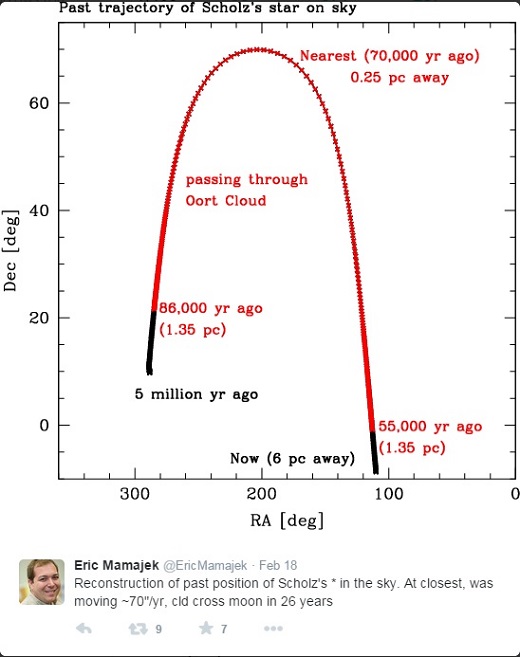
So we have the evidence of disrupted trajectories to back up the finding that Scholz’s Star made a close pass. ‘Oumuamua, incidentally, is not implicated in any of this. Its radiant is in the constellation Lyra, meaning it is not part of the over-density observed by the De la Fuente Marcos team. On the matter of deep space interlopers, though, it’s interesting that the paper names eight hyperbolic comets as being good candidates to have an interstellar origin.
The paper is C. de la Fuente Marcos, R. de la Fuente Marcos, S. J. Aarseth. “Where the Solar system meets the solar neighbourhood: patterns in the distribution of radiants of observed hyperbolic minor bodies,” MNRAS Letters, 2018 (preprint). The Mamajek paper is Mamajek et al., “The Closest Known Flyby of a Star to the Solar System,” Astrophysical Journal Letters 800 (2015), L17 (preprint).

Mission to an Interstellar Asteroid
On the matter of interstellar visitors, bear in mind that our friend ‘Oumuamua, the subject of yesterday’s post, was discovered at the University of Hawaii’s Institute for Astronomy, using the Pan-STARRS telescope. The Panoramic Survey Telescope and Rapid Response System is located at Haleakala Observatory on Maui, where it has proven adept at finding new asteroids, comets and variable stars. Consider ‘Oumuamua a bonus, and according to a new paper from Greg Laughlin and Darryl Seligman (Yale University), a type of object we’ll be seeing again.
Pan-STARRS may find objects like this every few years, but we’ll get a bigger payoff in terms of interstellar wanderers with the Large Synoptic Survey Telescope (LSST), now under construction at Cerro Pachón (Chile). Laughlin and Seligman think that this instrument will up the discovery rate as high as several per year, allowing us to see ‘Oumuamua in context, and also, perhaps, setting up the possibility of an intercept mission with a kinetic impactor.
More on that in a moment. But first, it’s interesting to see theories about its place of origin springing up in the brief interval since ‘Oumuamua’s passage. One of the stars of the Carina/Columba association (165-275 light years from Earth) is suggested, as is the double star system HD 200325. One recent survey of more than 200,000 nearby stars could find no conclusive evidence, but does suggest that 820,000 years ago, ‘Oumuamua encountered Gliese 876. There is even a possibility, which Laughlin and Seligman dismiss, that the object originally was ejected from our own Solar System and has now had a new encounter with it.
But back to a potential mission to ‘Oumuamua. What the authors have in mind is a kinetic impactor, which has the great advantage of producing a debris plume that we could look at with a spectroscope. We have a history of comet exploration dating back to Comet Giacobini Zinner in 1985 (International Sun-Earth Explorer), the flurry of missions — Giotto, Vega 1, Vega 2, Sakigake, Suisei — that investigated Comet Halley in 1986, the Deep Space 1 mission at Comet Borrelly (2001), and Stardust at Comet Wild 2. And the, of course, there is Deep Impact, a kinetic impactor that struck Comet Tempel I, and the European Space Agency’s highly successful Rosetta at Comet 67/Churyumov-Gerasimenko.
Even now we have the Osiris-REx mission enroute to the asteroid Bennu on a sample return mission. Thus a mission to an object from outside the Solar System seems feasible, though the challenges are obvious. As the paper notes:
Such a mission would face a number of challenges, including (1) the large heliocentric velocities of objects on hyperbolic trajectories, and (2) the lack of substantial time following the discovery of the target object for mission planning and execution, and (3) uncertainty in targeting during final approach. It is worth noting that when ‘Oumuamua was detected and announced in late October 2017, it had already passed its periastron location (which occurred on 9 September, 2017), and indeed, was already more than 1 AU from the Sun.
You may recall Andreas Hein and a team from the Initiative for Interstellar Studies, who have explored potential rendezvous missions to ’Oumuamua (see Project Lyra: Sending a Spacecraft to 1I/’Oumuamua). Laughlin and Seligman consider their mission as complementary to Hein and team, assessing how to investigate an interstellar object using chemical propulsion. Like Deep Impact, the actual impactor would be accompanied by a companion flyby probe that would examine the results spectroscopically. The feasibility of such a mission depends on having sufficient lead-time to launch the interceptor to the incoming object on a hyperbolic orbit.
Lead time is considered here in terms of the expected arrival directions and speeds of such objects. The authors do this by assuming a kinematic distribution similar to Population I stars, bearing in mind that the number of interstellar asteroids may be as much as 1016 higher than the number of stars. The paper samples the distribution of such asteroids in a cube of 10 AU around the Sun, pinpointing where they would be detectable and for how long. Such knowledge would allow us to determine optimal interception trajectories.
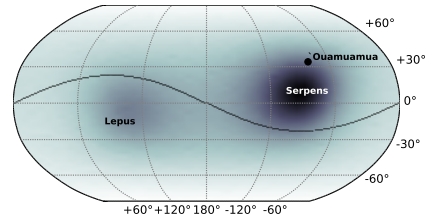
Image: This is Figure 3 from the paper. Caption: A sky map showing the probability that a future interstellar asteroid will approach the Solar System on a trajectory parallel to that direction. The darker colors indicate a higher probability. The axes denote degrees from a heliocentric point of view and the ecliptic is plotted in black. The sky positions of the constellations Serpens and Lepus, which are close in proximity to the Solar apex and anti-apex respectively, are plotted for context. The black circle indicates the sky location that ‘Oumuamua entered our Solar System, consistent with the prediction that the majority of these objects will approach with velocities parallel to the galactic apex. Credit: Laughlin & Seligman.
I send you to the paper for the specifics, but do note this with regard to ‘Oumuamua. When it was discovered, the object was three weeks beyond periastron passage, making reaching it problematic. Putting their trajectory analysis methods to work on ‘Oumuamua, the authors find that with an earlier detection, interception of ‘Oumuamua would not have been out of the question. Future interstellar asteroids could be reached given early detection and favorable trajectories — in fact, the authors conclude that wait times for mission opportunities should be in the range of 10 years, once we have the LSST (scheduled for first light in 2021) available.
And these interesting specifics on a potential mission:
The SpaceX Falcon Heavy quotes a payload capability to Mars of 16,800 kg, which we conservatively use for the payload constraint to L1. The Deep Impact mission to Tempel I had an impactor weighing ? 400 kg and a scientific package weighing ? 600 kg (A’Hearn et al. 2005). Due to the uncertainty of the position of the ISO [interstellar object], it seems appropriate to use ? 16 impactors, with a total weight of 400 kg. The mission program is greatly assisted by the expected 40 km/s velocity of impact with the hyperbolic ISO. Assuming that the remainder of the payload consists of fuel and oxidants, to account for the oxidants and efficiency of the rocket, we allow ? 1200 kg of fuel (with specific energy similar to compressed hydrogen) to produce the ?V. Equating the kinetic energy to the energy produced by the fuel, we calculate that a maximum ?V ? 15 km/s should be attainable, to impart the same amount of kinetic energy (per impact) as the Deep Impact Tempel I interception did.
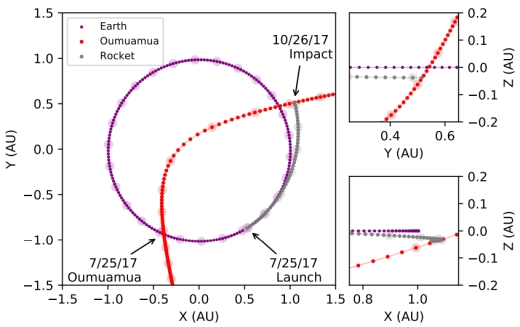
Image: This is Figure 7 from the paper. Caption: Trajectory of the minimum-?V mission interception mission sent on July 25th 2017, which had a flight time of 83.38 days. The trajectories for ‘Oumuamua, the Earth, and the rocket are plotted in red, blue and grey respectively in four day intervals in the smaller circles, while the larger circles are plotted in 28 day intervals. The arrows indicate the positions in space of ‘Oumuamua and the rocket on the launch and interception date, 7/25/2017 and 10/16/2016. Projections in the X-Y, Y-Z and X-Z planes are shown in the left, right upper, and right lower panel respectively. Credit: Laughlin & Seligman.
16 impactors to an interstellar asteroid on a manageable trajectory, with the promise of spectroscopic analysis to equal those we have achieved with previous cometary missions. With a discovery rate ramping up to several per year once LSST is available, we should have targets to work with in the 2020s, helping us learn whether what we know of ‘Oumuamua is indicative of the population of these objects. The close-up study of remnants of planetary formation around other stars is now becoming possible provided we know where to look and when to launch.
The Laughlin & Seligman paper is “The Feasibility and Benefits of In Situ Exploration of ‘Oumuamua-like Objects,” accepted at the Astronomical Journal and available as a preprint.

A Binary Origin for ‘Oumuamua?
The fleeting interstellar visitor we call ‘Oumuamua is back in the news, an object whose fascination burns bright given its status as a visitor from another star system. Just what kind of system is the subject of a new letter just published in Monthly Notices of the Royal Astronomical Society, in which Alan Jackson and colleagues argue that the star-crossed wanderer is most likely the offspring of a binary stellar system, these being far more likely to eject rocky objects. Our first confirmed interstellar asteroid just grows in interest.
Jackson (University of Toronto – Scarborough) is quoted in this news release from the Royal Astronomical Society as saying that the odds didn’t favor the first interstellar object detected in our system being an asteroid. Comets are more likely to be spotted, and our system is more efficient at ejecting comets than asteroids. But ‘Oumuamua is what we got, and its eccentricity of 1.2 and 30 km/sec speed pegged its orbit as hyperbolic, clearly not bound by the Sun’s gravity.
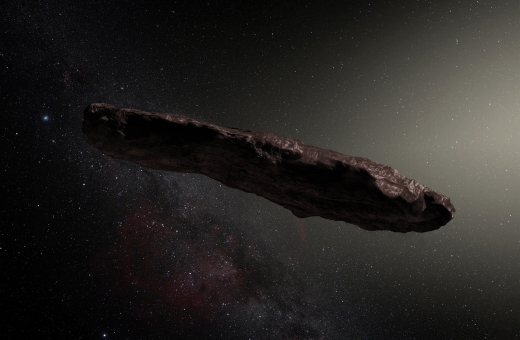
Image: Artist’s impression of ‘Oumuamua. Credit: ESO / M. Kornmesser.
How much do we know about what our Solar System can eject? For this, I turn for a moment to Greg Laughlin and Konstantin Batygin, who make this case in “On the Consequences of the Detection of an Interstellar Asteroid” (citation below):
Our own solar system has contributed many volatile-rich planetesimals to the galaxy. Specifically, within the framework of the so-called Nice model of early solar system evolution, (Tsiganis et al. 2005; Levison et al. 2008), a transient period of dynamical instability is triggered in response to interactions between the giant planets and a primordial disk comprising ? 30M?. In numerical realizations, nearly all of this material is expelled into the interstellar medium as the instability unfolds, leaving behind today’s severely mass-depleted Kuiper belt. Given the universality of N -body evolution, one can speculate that similar sequences of events are a common feature of planetary system evolution.
Jackson and team are frank in acknowledging that with only a single interstellar object to work with, we have to assume huge uncertainties in the constraints we apply to the mass of material typically ejected from planetary systems. That point hardly needs belaboring, but we press on with the data we have to work with, keeping in mind how much play there is in our estimates.
The case for binary systems and ejected material runs like this. ‘Oumuamua shows no evident activity, making the case that it is a rocky object shorn of volatiles, and hence one that was ejected from inside its parent star’s snowline. For a star of solar mass to eject an object from within its snowline requires a companion object with a mass greater than Saturn. But our radial velocity surveys show a low occurrence rate of giant planets (~10 percent) with orbital periods of 100 to 400 days. Here the authors cite the Laughlin/Batygin paper above, which argues that ‘Oumuamua, if it is indeed rocky, implies that extrasolar asteroid belts are massive.
Giant planets inside the snowline are relatively uncommon, but binary systems are abundant, and are known to be efficient at ejecting material. The authors draw the following conclusion:
…we expect that at most 10% of Sun-like single stars will host a planet capable of efficiently ejecting material interior to the ice line. Laughlin & Batygin (2017) and Raymond et al. (2017) thus argue that if 1I/‘Oumuamua is indeed rocky, then typical extrasolar asteroid belts must be unusually massive. Similarly, recent results from micro-lensing surveys (e.g. Suzuki et al. 2016; Mroz et al. (2017) suggest that giant planets at larger separations are also not common….While giant planets are relatively uncommon, tight binary systems are abundant (Duchene & Kraus 2013), and are extremely efficient at ejecting material (Smullen et al. 2016). They may therefore represent a dominant source of interstellar small bodies.
Jackson and team conducted 2000 N-body simulations to study close encounters and ejections, finding that the fraction of rocky or devolatilised material ejected by binaries is 36 percent — the ratio of icy to rocky objects is roughly 2:1. Moreover, these simulations show that the population of icy interstellar material comes primarily from low mass stars, while the population of rocky material is dominated by intermediate mass stars.
The best guess for ‘Oumuamua: A hot, high mass binary system ejecting rocky material during the formation era of its planets. As to the ejection process itself, the paper comments:
Physically, our picture is one of planetesimals migrating inwards during the early phases of planet formation, in the presence of a protoplanetary disk. Holman & Wiegert (1999) showed that any material in circumbinary orbit migrating inward will become unstable on short timescales once it passes a stability boundary ac,out, for which they provide an empirical fit to results from N-body simulations (their equation 3). This critical distance is a function of the binary mass ratio and eccentricity and ranges from around 2 to 4 times the binary separation…
Thus we have inward planetesimal migration followed by ejection from the binary system when the object passes the stability boundary. The authors’ models show that more than 75 percent of interstellar bodies originate from binary stars, a number that is even higher for rocky objects.
Even if a typical circumbinary only ejects as much material as the Solar system we would still expect close binaries to be the source of more than three quarters of interstellar bodies due to the relatively low abundance of single star systems with giant planets like the Solar system. Whereas in the Solar system the ejected material is overwhelmingly icy, we expect that around 36% of binaries may predominantly eject material that is rocky or substantially devolatilised, leading to similar expectations for the abundance of rocky/devolatilised bodies in the interstellar population.
“The same way we use comets to better understand planet formation in our own Solar System,” says Jackson, “maybe this curious object can tell us more about how planets form in other systems.” Of course it will take more than one such object to do the job, but we’re learning that future detections of interstellar objects are likely as estimates of their occurrence rise.
The paper is Jackson et al., “Ejection of rocky and icy material from binary star systems: Implications for the origin and composition of 1I/‘Oumuamua,” Monthly Notices of the Royal Astronomical Society 19 March 2018 (abstract). The Laughlin/Batygin paper is “On the Consequences of the Detection of an Interstellar Asteroid,” submitted to Research Notes of the AAS (abstract).

